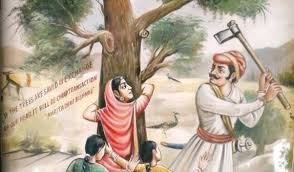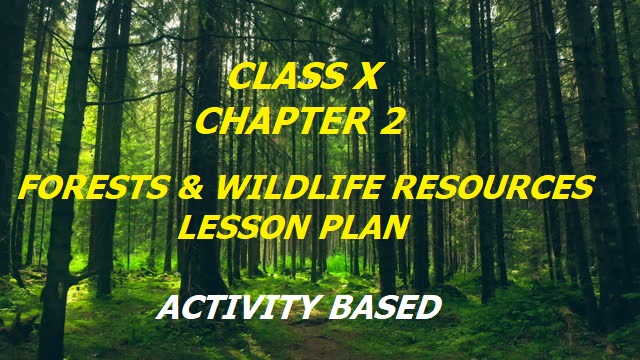A Comprehensive Forests and Wildlife Resources Lesson Plan
A Comprehensive Forests and Wildlife Resources Lesson Plan mainly deals with the interdependence of various resources and the need for their judicious use. The Forests and Wildlife Resources Lesson Plan also highlights the importance of preserving resources for future generations and the role of individuals, communities, and governments in achieving sustainable development through activities.
In this lesson, we will explore the fascinating world of forests and wildlife resources.
We will learn about the different types of forests and their characteristics, the importance of forests for the environment and human beings,
and the different types of wildlife and their habitats.
We will also discuss the threats in our Forests and Wildlife Resources Lesson Plan and the different conservation measures that can be taken
to protect them.
Through inquiry-based learning, visual aids, and real-world examples, students will gain a deeper understanding of the importance of forests
and wildlife resources and the need for their conservation.
Class 10 Social Science (Geography) Chapter 1 Resources and Development Lesson Plan
Forests and Wildlife Resources: A Comprehensive Lesson Plan
Lesson Title: Forests and Wildlife Resources
Grade Level: 8-10
No. Of Periods: 5-6
General Objective:
- To create interest in the subject.
- To understand the importance of resources.
Specific Objective:
- To understand the importance of forests and wildlife resources for human beings and the environment
- To identify the different types of forests and their characteristics
- To recognize the different types of wildlife and their habitats
- To describe the threats faced by forests and wildlife resources and their conservation measures
Teaching Points:
- Introduction to forests and wildlife resources
- Types of forests and their characteristics (tropical, temperate, and boreal forests)
- Types of wildlife and their habitats (mammals, birds, reptiles, amphibians, and insects)
- Threats to forests and wildlife resources (deforestation, habitat loss, climate change, poaching, and hunting)
- Conservation measures for forests and wildlife resources (afforestation, reforestation, wildlife sanctuaries, national parks, and wildlife conservation laws)
Teaching Aids:
- Physical and Political map of India.
- Map of forest cover in India
- Audio and videos
- PPT
- Blackboard and chalk.
Methodology – Forests and Wildlife Resources Lesson Plan
Inquiry-Based Learning
The teacher will use inquiry-based learning to encourage students to ask questions, investigate, and discover new knowledge about forests
and wildlife resources.
The teacher will also ask open-ended questions that encourage critical thinking,
such as “Why are forests important?” or “What are the different types of wildlife and their habitats?”
Active Learning
By using an active learning strategy the teacher will engage students in the learning process.
For example, take students on a forest walk, have them create a habitat diorama, or assign them a conservation proposal.
The teacher also Uses group discussions, debates, and presentations to encourage students to share their ideas and perspectives.
Visual Aids
Visual aids such as diagrams, photographs, and videos will help students visualize and understand the different concepts related to
forests and wildlife resources.
For example, the teacher will use a map to explain the different types of forests.
Also, will show a video of a wildlife sanctuary to help students understand the importance of wildlife conservation.
Real-World Examples
The teacher will also use real-world examples to help students connect the concepts they learn in the classroom to the real world.
For example, the teacher will discuss case studies of deforestation or habitat loss to help students understand the impact of human activities
on forests and wildlife resources.
Flipped classroom
Lastly, the teacher will apply the flipped classroom teaching methodology that involves students in a self-directed learning process.
In this approach, the teacher will provide students with online resources such as videos, podcasts, and readings before the class.
During the class, students will engage themselves in discussions, group activities, and problem-solving exercises related to the topic.
This approach will help students to develop self-directed learning skills and critical and collaboration skills.
Activities From Forests and Wildlife Resources Lesson Plan
Activity 1 Forest Walk:
The teacher will take students for a nature walk in a local nearby forest.
These students will observe and identify different types of trees, plants, and animals found in the forest.
The teacher will also encourage students to take photographs or draw sketches of the plants and animals they observe.
Activity 2 Wildlife Documentary
The teacher will show a wildlife documentary that showcases different types of wildlife and their habitats.
After watching the documentary, students can discuss the different types of wildlife and their habitats.
Activity 3 Habitat Diorama
In this activity, the teacher will divide students into groups.
Each group will be assigned a type of habitat (e.g., tropical rainforest, desert, tundra).
Students will have to research and create a diorama of the habitat, including the plants and animals that live there.
Activity 4 Resource mapping
The teacher will divide students into groups.
Each group will be assigned a different region or country to research.
The students have to create a resource map of the region/ state or country,
They will identify and categorize the type of forest and wildlife available.
Then, each group will present its map to the class.
They will also compare and contrast the availability and distribution of resources in different regions.
Activity 5 Threats and Conservation Measures
Here, the teacher will assign each student a particular threat to forests and wildlife resources (e.g., habitat loss, climate change, poaching).
Students have to research the threat and present their findings to the class.
Then, they have to discuss and propose conservation measures to address the threats.
Find out, why are the Amazon forests shrinking.
Assessment:
Forests and Wildlife Resources Quiz
Give students a quiz that assesses their understanding of the importance of forests and wildlife resources.
They will also learn and prepare about the different types of forests and wildlife.
And know about the threats faced by forests and wildlife resources and their conservation measures.
Students will be provided with a worksheet from this chapter which will contain short questions, Assertion & Reason, Picture based questions with current knowledge.
Conservation Measures Proposal
Have each student present their proposed conservation measures to address a particular threat to forests and wildlife resources.
Evaluate the proposals based on their feasibility, effectiveness, and creativity.
Find out which animal is protected in the Kaziranga National Park.
Map Work:
Students will have to prepare a map related to the types of forests and wildlife sanctuaries found in India.
Classwork:
Sohot questions, MCQ, and source-based questions will be done in the class.
The teacher will also guide the students in writing perfect answers in Board exams.

Homework:
Read about the Chipko movement, Joint Forest Management (JFM), and Saristka Wildlife Reserve.
NCERT GEOGRAPHY CLASS 10 CHAPTER 2 FORESTS AND WILDLIFE RESOURCES – WORKSHEET
Learning Outcomes:
After the completion of the chapter, the students will be able to
- identify and describe the different types of forests and their characteristics.
- recognize the different types of wildlife and their habitat.
- understand the importance of forests and wildlife resources for human beings and the environment
- describe the threats faced by forests and wildlife resources and their conservation measures.
- propose conservation measures to address the threats to forests and wildlife resources.
Remedial Measures:
- If students struggle to identify the different types of forests and their characteristics, the teacher will provide them with additional resources such as visual aids, diagrams, and videos that help them understand the differences between tropical, temperate, and boreal forests.
- The teacher will help slow learners who face difficulty in recognizing the different types of wildlife and their habitats. They will be provided with more examples and opportunities to observe and study different types of wildlife in different habitats.
- Discussions and debates will help slow learners see the relationship between forests, wildlife, and the environment.
- The teacher will also provide case studies and real-world examples to help them understand the issues in a more practical context. This will help the students understand the threats faced by forests and wildlife resources and their conservation measures. Have you heard about the role of the Bishnoi community in the conservation of Forests and wildlife?
Forests and Wildlife Resources – Class X Notes With 1,3 & 5 Mark Questions
NCERT GEOGRAPHY CLASS 10 CHAPTER 2 FORESTS AND WILDLIFE RESOURCES – WORKSHEET
Conclusion On A Comprehensive Forests and Wildlife Resources Lesson Plan
I hope that this Lesson Plan on Forests and Wildlife resources will cater to the need of all students. New classroom activities involved in the Forests and Wildlife resources Lesson Plan will involve the students in the teaching-learning process. However, the chapter is very big and contains lots of concepts e.g. Chipko movement, Beej bachao Andolan, Joint Forest Management, and forest conservation. Therefore, it also requires detailed Forests and Wildlife resources lesson plans beforehand.
If you have conducted any classroom activity, you are free to share.
Challenging Question for my readers:
How many Cheetahs have been brought to India recently by the Government of India?
They are kept in which wildlife sanctuary?





0 Comments